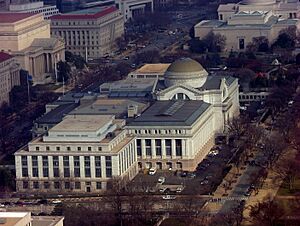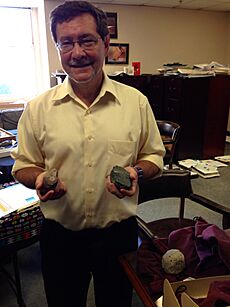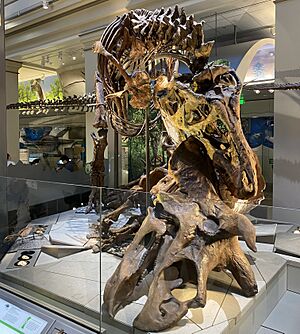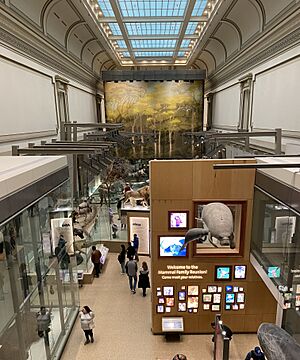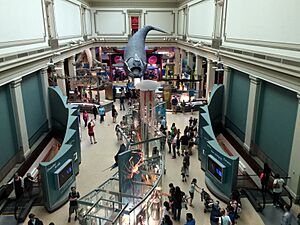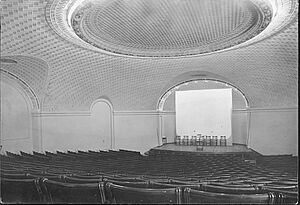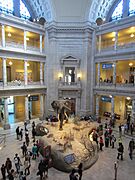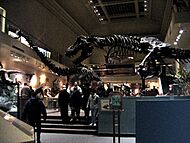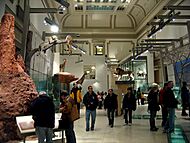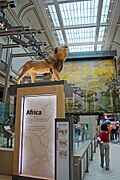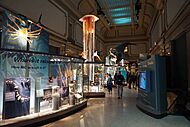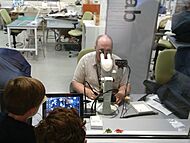National Museum of Natural History facts for kids
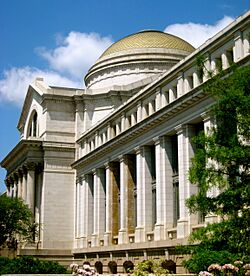
View of the main facade from Madison Drive
|
|
| Established | 1910 |
|---|---|
| Location | National Mall in Washington, D.C., United States |
| Type | Natural history museum |
| Collection size | 146,000,000 specimens |
| Visitors |
|
| Public transit access | |
The National Museum of Natural History (NMNH) is a super cool place to explore nature and history! It's run by the Smithsonian Institution and is located on the National Mall in Washington, D.C., USA. The best part? It's completely free to visit and is open almost every day of the year. In 2023, over 4.4 million people visited, making it one of the most popular museums in the United States.
The museum building opened in 1910. It was one of the first Smithsonian buildings made just for national collections and research. The main building is huge, with over 1.5 million square feet of space. About 325,000 square feet are for exhibits and public areas. More than 1,000 people work there.
The museum has an amazing collection of over 146 million items. These include plants, animals, fossils, minerals, rocks, meteorites, and human cultural artifacts. It's the largest natural history collection in the world! It's also home to about 185 professional scientists. This is the biggest group of scientists anywhere who study natural and cultural history.
Contents
Discovering the Museum's Past
Early Days: 1846–1911
The United States National Museum started in 1846. It was part of the Smithsonian Institution. At first, the museum was in the Smithsonian Institution Building, also known as the Smithsonian Castle. A proper exhibit hall opened in 1858.
As the collection grew, a new building was needed. This was the National Museum Building, now called the Arts and Industries Building. It was built very quickly, in just 15 months, and opened in March 1881.
Congress decided a new, even bigger building was needed in 1902. They chose a spot on the north side of the National Mall. The D.C. firm of Hornblower & Marshall designed the building.

The Natural History Building, as it was first known, opened on March 17, 1910. It gave the Smithsonian more room for its growing collections and research. The building was fully finished in June 1911. It cost about $3.5 million back then. This Neoclassical style building was the first one built on the north side of the National Mall. It held natural history, American history, art, and cultural collections.
Leaders and Growth: 1981–2012
Many directors led the National Museum of Natural History over the years. Frank Talbot, a fish expert, was director from 1989 to 1994. He was the first Australian to hold this job.
In 1997, Kenneth E. Behring gave $20 million to help update the museum. This was one of the biggest donations in Smithsonian history.
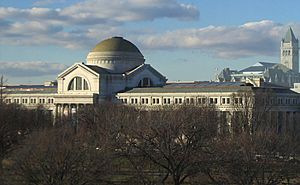
In 2003, Cristián Samper became the museum's director. Under his leadership, the museum opened the Behring Hall of Mammals in 2003. It also received large donations for the Sant Hall of Oceans and the National Gem Collection.
In 2007, Samper became the Acting Secretary of the Smithsonian. During this time, there were discussions about how the museum presented information on global warming in an exhibit. Samper stated the museum aimed to present scientific evidence clearly.
In 2008, the Victoria and Roger Sant family donated $15 million for the new Ocean Hall. In 2009, the museum celebrated 50 years of having the Hope Diamond. They gave it its own special exhibit. In 2010, the $21 million human evolution hall opened.
In 2012, Kirk Johnson became the new director. He had been the vice president of research and collections at the Denver Museum of Nature and Science. By 2013, Johnson was in charge of a museum with 460 employees and a $68 million budget. The museum's main building was added to the National Register of Historic Places in 2023.
Exploring Research and Collections
The museum's research is split into seven main areas:
- anthropology (the study of humans)
- botany (the study of plants)
- entomology (the study of insects)
- invertebrate zoology (the study of animals without backbones)
- mineral sciences (the study of minerals)
- paleobiology (the study of ancient life, like fossils)
- vertebrate zoology (the study of animals with backbones)
The NMNH holds 90% of all the Smithsonian Institution's collections. It's one of the biggest and most complete natural history collections in the world. There are about 146 million items! This includes 30 million insects, 4.5 million plants, and 7 million fish. The collection of amphibians and reptiles has grown a lot, from 190,000 in 1970 to over 580,000 in 2020.
About 2 million cultural items are also part of the collection. Many of these are photographs. The museum lends out about 3.5 million specimens every year for research. Most of the collections not on display are kept in special research areas. They are also stored at the Museum Support Center in Maryland. The museum also has marine science centers and field stations in other countries.
Amazing Exhibitions
Hall of Geology, Gems, and Minerals
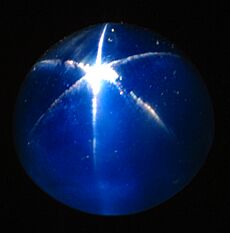
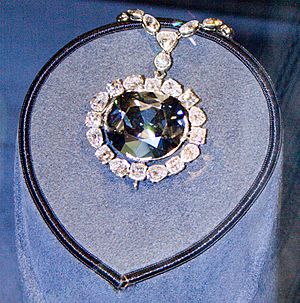
This hall has one of the most important collections of gems and minerals anywhere. It includes over 15,000 gems, 350,000 minerals, and 300,000 rock and ore samples. The museum also has about 45,000 meteorites. This collection is considered one of the best in the world.
You can see famous pieces like the Hope Diamond and the Star of Asia. The Star of Asia is one of the largest sapphires in the world. There's also the Carmen Lúcia Ruby, which is one of the biggest and most valuable Burmese rubies.
This collection is shown in the Janet Annenberg Hooker Hall of Geology, Gems and Minerals. Many important people have donated to this collection. These include Washington Roebling, who helped build the Brooklyn Bridge, and Isaac Lea.
Hall of Human Origins
The David H. Koch Hall of Human Origins opened on March 17, 2010. This was the museum's 100th anniversary. David H. Koch gave $15 million for this exhibit.
This hall helps you discover and understand how humans came to be. It covers 15,000 square feet. You can see 76 human skulls from different species, showing how humans evolved over millions of years. For example, you can see Homo heidelbergensis, which lived 200,000–700,000 years ago. There's also a skull from Homo floresiensis, a human species that might have lived until just 17,000 years ago.
The exhibit has an interactive human family tree. It shows six million years of evolution. There's also a "Changing the World" gallery. This part looks at how humans impact the world. The main idea of the hall is "What Does It Mean To Be Human?" It focuses on big steps in human evolution, like walking upright, bigger brains, and thinking symbolically.
The exhibit also shows the Smithsonian's research on how geology and climate changed in East Africa. These changes happened during important times in human evolution. You can see a real Neanderthal fossil and amazing replicas made by paleoartist John Gurche.
Deep Time Exhibit/Fossil Hall

The Hall of Dinosaurs has fossilized skeletons and models. You can see a Tyrannosaurus rex cast facing a Triceratops cast. This exhibit even shows the first accurate dinosaur skeleton moving virtually! The collection has 46 important and complete dinosaur specimens.
In May 2012, David H. Koch donated $35 million to help update the dinosaur hall. The hall closed in April 2014 and reopened in June 2019.
In June 2013, the Smithsonian got a 50-year lease for a T. rex fossil skeleton. This was the first T. rex skeleton to be shown at the museum. Before this, they only had a cast of a skull. The skeleton, known as the "Wankel" or "Devil" rex, was found in Montana in 1988. It's about 85 percent complete. This 35-foot-long skeleton is the main attraction of the dinosaur hall since it reopened in 2019.
The "Nation's T. rex" arrived at the museum on April 15, 2014. It traveled in 16 crates from Montana. The T. rex was displayed in the Rex Room. Experts checked its condition and scanned each bone to create a 3-D model for research.
Hall of Mammals
The Behring Hall of Mammals shows mammal specimens like modern art. Visitors can learn how mammals have adapted to many different environments.
The museum has the largest collection of vertebrate specimens in the world. This includes important collections from the 1800s and early 1900s.
Insect Zoo
The O. Orkin Insect Zoo has live insects! You can also learn about insects and entomologists (scientists who study insects). Different habitats show insects that live in places like a freshwater pond, a house, a mangrove swamp, a desert, and a rain forest. You can see how they have adapted to these homes. Orkin, a pest control company, sponsors the zoo.
Ocean Hall
The Sant Ocean Hall opened on September 27, 2008. It was the biggest update to the museum since it first opened. The hall has 674 marine specimens and models. These come from the museum's huge collection of over 80 million specimens. The hall is named for the Roger Sant family, who donated $15 million.
The collection includes a North Atlantic right whale and a giant Lion's mane jellyfish model. There's also a 1,500-gallon aquarium with live marine fish and corals. You can see a female giant squid in the center of the hall and a male off to the side.
The museum also has the Smithsonian Ocean Portal website. It shares new information from the museum's research and the Sant Ocean Hall.
African Voices
This exhibit and its website explore the many different cultures of Africa. It shows how African people and cultures have changed over time. It looks at family, work, community, and the natural environment.
Butterflies + Plants: Partners In Evolution
The Butterflies + Plants is a live butterfly pavilion. Here, you can watch how butterflies and other animals have evolved. You can see how they have adapted and changed together with their plant partners over millions of years.
Bone Hall
This exhibit shows many different vertebrate skeletons. They are grouped by how they are related through evolution.
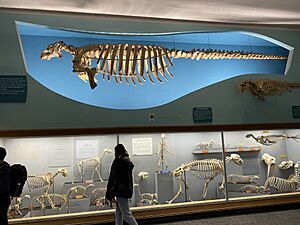
Q?rius
Opened in 2013, Q?rius is the museum's interactive learning area. You can use microscopes and touch screens for different activities. There's a "collection zone" with over 6,000 specimens and artifacts that visitors can actually touch! The area also hosts events where you can meet Smithsonian scientists.
Museum Facilities
In the lower level, there's a bird exhibit called the Urban Bird Habitat Garden. It features all the migratory and native birds found in Washington, D.C.
The Global Volcanism Program is located in the museum's mineral sciences department.
The museum often hosts sleepovers for children aged 8–12 through the Smithsonian Associates program.
Baird Auditorium
Underneath the museum's main rotunda is the Baird Auditorium. It's named after Spencer Fullerton Baird, the second Secretary of the Smithsonian. The auditorium was finished in 1909. It was designed by the R. Guastavino Company. The American Institute of Architects calls it the museum's "greatest interior space." Its ceiling is a shallow dome made of special tiles.
Baird Auditorium Events
The Baird Auditorium has hosted many famous events. In 1920, it was the site of the "Great Debate" between astronomers about spiral nebulae and the size of the universe. Famous musicians have also performed there. Merle Travis gave a country guitar concert in 1976. In 1977, Muddy Waters performed as part of the Smithsonian's blues series.
Gallery
See also
 In Spanish: Museo Nacional de Historia Natural de los Estados Unidos para niños
In Spanish: Museo Nacional de Historia Natural de los Estados Unidos para niños
- John Varden
- List of most-visited museums in the United States


